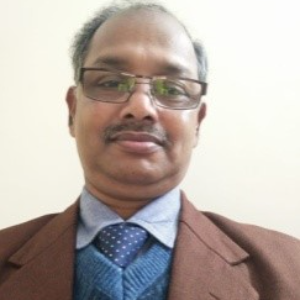Title : Green synthesis of hierarchically structured organic-inorganic nanohybrid on cotton fabric suitable for antimicrobial and oil-water separation applications
Abstract:
In textile and apparel industry, cotton is the most widely used natural fiber owing to its soft, breathable and eco-friendly nature along with ease of mass production. But high moisture absorption and retention capacity make them prone to grow pathogenic bacteria and fungi. These microbial growth and proliferation reduces the shelf-life of the fabric as well as enhances the chance of microbial infections in human beings. Several nanomaterials are being used for obtaining antimicrobial cotton fabrics. Most notable non-metallic nanoparticles are chitosan and graphene / reduced graphene oxide. An extensively used metal or metal oxide nanoparticles are Ag, Cu, Cu2O, CuO, TiO2, ZnO and so on. It is to be noted that the antimicrobial activity of the nanoparticles may originate from their high surface to volume ratio owing to their nanodimension for which they can interact and attach closely with the microbial cell membranes. On the other hand, metal and metal oxide nanoparticles (NPs) are known to have antimicrobial activities against a large spectrum of bacteria, fungi and viruses. The mechanism behind this activity involves metal ions release, oxidation stress that generated from reactive oxygen species (ROS), and internalization of NPs resulting to cell death.
In today’s world, scientific and technological innovations are taking place. These innovations include development of numerous functional nanomaterials among which hierarchically structured nanomaterials (HSNs) are most important owing to their enormous applications in different areas like biomedical, wastewater management, energy storage, sensing and so on. As an alternative to conventional synthesis methods which can cause harmful effects to human health and environment, several green chemical, physical and biological methods for producing different metal and metal oxide based HSNs are known. The adoption of these methods is found to be increasing rapidly as these methods are environmentally sustainable. Some cases, these are also energy efficient. Green chemical and physical methods involve use of environmentally benign solvents and reagents.
Now-a-days, super-wettable cotton fabrics have gained significant attention towards separation of oil-water mixtures. The reasons behind the popularity are the ease of surface modification, high flexibility and inherent micro-scale roughness of cotton fabric that can reduce the effective contact area between an upcoming liquid with solid surface. In case of on-demand separation of light oil-water and heavy oil-water mixtures, switchable super-wettability (superhydrophobicity) and underwater superoleophobicity is highly advantageous. In this regard, the external stimuli such as light, heat, pH and also partial surface modification or pre-wetting strategy can be used to achieve intelligent surfaces with switchable superwettability. Sometimes, the presence of hollow microstructures in the coating can be beneficial towards obtaining high reusability of filtration materials without losing the separation efficiency.
In this talk, the green synthesis strategy based organic-inorganic nanohybrid and the derived different hierarchical structures with special emphasis on Ag-Cu2O hollow hierarchical structures on cotton fabric (ACN) along with their challenges and future prospect will be discussed. The role of various reaction parameters upon the formation of such structures, the wetting behaviour of original (ACN) and modified fabric (ACNS) with hexadecyltrimethoxysilane (a low energy material) and the stability of the fabricated coatings will be shared to the august gathering. In addition, the effect of surface modification and the wettability of the kinetics of contact killing of bacteria (E. coli and S. aureus) and fungi (C. albicans) with long term antimicrobial activity of the materials will be discussed. Also, the performance of the coated fabrics employed for on-demand separation of light/heavy oil-water mixtures and their switchable wettability will be shared with the audience. Moreover, the self-cleaning performance of coated fabrics will be discussed. In brief, our research findings on the fabrication of unique structures of the organic-inorganic nanohybrid through green synthesis strategy and the effect of surface modifications towards generating multifunctional material properties will be the goal of this talk.
Audience take away:
- A time bound and challenging research is progressing well globally towards development of various kinds of advanced functional nanomaterials adopting green synthesis strategy. This is highly required because of the environmental pollution of hazardous chemicals are being used in different conventional synthesis routes. This talk will primarily cover the use of green chemicals, green solvents etc. to develop the hierarchically structured organic-inorganic hybrid coating materials on cotton fabric with antibacterial and other advanced properties. On the other hand, world is still suffering COVID-19 disease. These organic-inorganic materials, a prime discussion of this talk is very much essential for the society in everywhere including medical purposes. Hence, the developed materials through the facile and cost effective synthesis method will help audience can acquire knowledge and ideas for their career building. In addition, they can learn the present challenges of the functional organic-inorganic hybrids by green synthesis method and their future prospect so that it helps them for further innovation.
- The organic–inorganic nanohybrid materials with hierarchically structures synthesized by green synthesis method have wide applications. As the talk will cover the material fabrication method, the researchers could find out for other of the materials with hierarchical structures for obtaining potential applications in different fields.
- This talk will enrich basics as well as applied knowledge for young researchers on the state-of-the art research in hierarchically surface structured organic-inorganic nanohybrid materials (HSOIH) with potential applications.
- Different fabrication strategies including green chemical synthesis method will help the researchers to design different types of novel HSOIH in a facile pathway for future.
- HSOIH can find a huge numbers of applications like antimicrobial, self-cleaning, optical sensing, energy and environmental remediation including oil-water separation applications. Hence, the researchers can find an opportunity to apply the knowledge of the fabricated HSOIH and also they can apply on new and unexplored field of applications.
- To discuss on different HSOIH systems and also to share the expertise amongst the esteemed gathering on this virtual conference towards the researchers who are working in this area of research.



